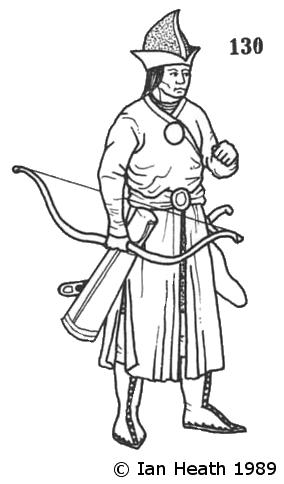
Try Amazon Fresh
CUMAN, 12th-13th CENTURIES
An extract from Armies of Feudal Europe 1066-1300by Ian Heath
[Based on the St. Ladislaus Legend in the Képes Krónika]



130. CUMAN, 12th-13th CENTURIES
The Cuman or Kipchak Turks were probably descended from a branch of the Ghuzz. They appeared on the borders of Kievan Russia in 1054, crossed the Carpathians in 1070 and were established along the Danube by 1090, by which time there were effectively 5 independent groups; these were based respectively in Central Asia, the Urals, along the Donets-Don, along the lower course of the Dnieper, and on the Danube, the last group being that relevant to Hungarian and Byzantino-Bulgarian history.
In the early-13th century Robert de Clan, a participant in the Fourth Crusade, wrote the following succinct description of the Cumans: 'They are a savage people, who neither plough nor sew, and they have neither huts nor houses but instead they shelter in heavy tents made of felt, and they live on milk and cheese and meat… Each one has at least 10 or 12 horses, which are so well-trained that they follow anywhere they are led; and they mount first on one and then an another [and so on]. When they are on a raid, each horse has a bag hung on his nose in which his fodder is put, and he eats as he follows his master, but they do not stop moving by night or by day. And they ride so hard that they cover in one day and night fully 6 days' journey, or 7 or 8. And while they are on their way they will not seize or carry along anything until they are on their way back, but while returning they seize loot and prisoners and anything else they can get. Nor do they go armed, except that they wear a garment of sheepskin and carry bows and arrows.' Byzantine and Russian sources add lances, sabres, lassoes, maces, javelins, shields and armour to this list of equipment, the Cumans being noted for their accuracy with javelins. Shields were either circular or almond shaped. Better-armoured types would have resembled figures 137-139 below. Like all steppe peoples they wore no spurs, instead controlling their horses with a short whip.
Though from a 14th century source (the 'Képes Krónika', illustrated in the 1360s) this figure can doubtless be taken as characteristic of at least 12th-13th century Cumans too. (See also figures 84-86 in Armies of the Middle Ages, volume 2.) Dress basically comprised a long topcoat (here with side-vents), knee-length tunic, trousers, pointed cap, and boots or shoes with brocade, linen, fur and wool all in evidence. In general appearance the Cumans were handsome, blue eyed and blonde-haired*; despite what I have written elsewhere, it was doubtless their hair rather than their skin colour that gave rise to the Russian and German names Polovtsy and Falven given to the Cumans, these originating from words meaning 'yellow'. Their hair was worn long but they shaved their chins, though long moustaches were often worn.
Although many settled in Bulgaria (especially in Dobrudja and Bessarabia) and, after the Mongol invasions, in Hungary, the Cumans remained tent-dwelling nomads for most of this period (see page 43), and utterly pagan to boot; Joinville, for instance, records the burial alive of a horse and servant in the kurgan of a deceased chieftain even in the mid-13th century.
*The Pechenegs, by contrast, were stocky, olive-skinned and ugly, with long black hair that in battle was often worn in a pigtail stuffed under their caps or helmets.